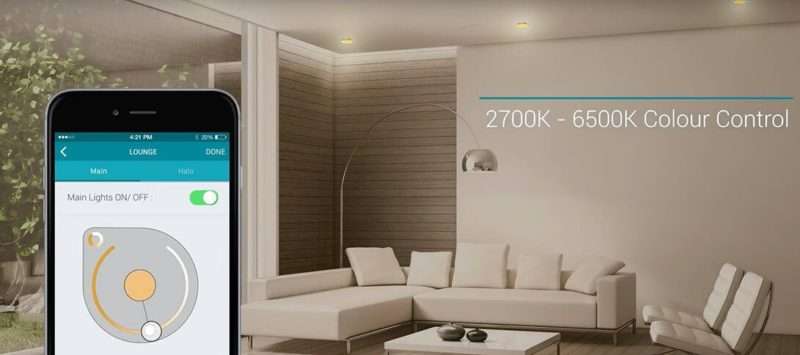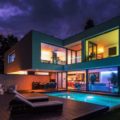For a century, our relationship with our lighting has been a basic one.
On. Off. On. Off. On.
Then later: dim a little. Dim a little more. Off.
Smart lighting changes all that. Now you can take the kind of control over your lighting that was long thought of as science-fiction. Have your lights respond to your voice, or even just your presence, or use your smartphone to operate the lights in your home from thousands of miles away.
It might sound like something from the future, but the technology is already here, and it’s here to stay.
So what is smart lighting?
Smart lighting systems connect to your home Wi-Fi network and allow you to operate your lights through a smartphone app. You can adjust the colour temperature of individual light bulbs or change the colour of them completely. Set up schedules so the lights switch on and off at specific times. Activate your lights when you’re away on holiday to make it look like someone’s home, deterring would-be burglars.
Some smart lighting systems, such as Philips Hue, OSRAM Lightify, Crompton Smart and LIFX, are compatible with ‘Smart Home’ systems like Amazon Echo or Google Home, meaning you can use voice commands to operate your lighting. This allows you to get really creative with how you use your lights.
You could tell your smart home system when you’re going to bed and the lights will switch off as you’re on your way upstairs. Say goodbye as you’re on your way out of the door and let your lights switch themselves off then, too.
How does smart lighting work?
Most smart systems will operate around a central ‘bridge,’ a device that connects to your home Wi-Fi network and allows you to control your lights through your smartphone. Some newer smart light bulbs such as the Crompton Smart range do not require a bridge to function.
Some smart systems use an industry-standard wireless protocol called Zigbee to communicate with each other. It is similar to your Wi-Fi signal, but one big difference is that where products connected to a Wi-Fi network can only communicate with one central router, Zigbee products can communicate with each other.
This means that each light bulb in your smart system can relay the signals from the bridge to each other. So, even if your bridge is on the other side of the house, the ‘boost’ in the signal provided by each product extends the range considerably.
What types of smart light bulb are available?
There are many types of light bulbs available on the market, and each smart lighting system will have its own range, from GLS light bulbs with adjustable colour temperatures, and even RGB output to flexible, colour-changing LED strips that are great for back-lighting and running behind cabinets and shelves.
The versatility of smart lighting means that you can control individual light bulbs, group light bulbs or even the lights in a whole building. You could set lighting themes, so when you’re watching a movie, for instance, the lights around the room dim except for the back-lighting around your television.
Most smart light bulbs are retrofitted to standard light fixtures, meaning you just have to find the right kind of cap and replace the existing light bulb in its fitting.
What happens if I have problems with my Wi-Fi?
Smart lights use your Wi-Fi network to operate, but if your internet connection goes down, fear not. Smart lighting manufacturers make sure that you won’t be stuck in the dark or with a houseful of lights on.
You may lose some functionality when you’re out of the house (e.g. being able to control your lights through your smartphone) but as long as the bridge (if required) is still linked to your Wi-Fi router, even if it can’t connect to the internet, you should still be able to control your lights when you’re home.
The future of smart lighting
Smart lighting will be one aspect of the Internet of Things (IoT), a network of ‘smart’ appliances that are connected to the internet.
Imagine setting this morning schedule via your smartphone:
Your alarm sounds and you switch it off (or snooze it) with a sleepy voice command. A few minutes later, the lights slowly come on, or the window blinds roll up to coax you out of bed.
Barely noticed by you, the lights in each room activate as you stagger around the house getting ready. The toast pops and the coffee machine finishes brewing just as you step into the kitchen.
You take a couple of minutes longer than usual to eat your breakfast, so just before it gets to the time where you’ll hit traffic, a friendly voice pipes up and reminds you it’s time to go. Your car switches itself on as your front door locks automatically behind you, and as you drive away, the house lights slowly dim, before switching themselves off.
Imagine this technology across a whole city, where streetlights activate when cars are nearby. A city where traffic lights are synced exactly with the vehicles approaching and the headlights of the cars themselves are automatically tuned to match the conditions outside.
This is the direction that technology is heading in, a vast interconnectedness designed to make our lives simpler and more convenient. Smart lighting is a small step in that direction, a model of the future-ready for us to use now.




